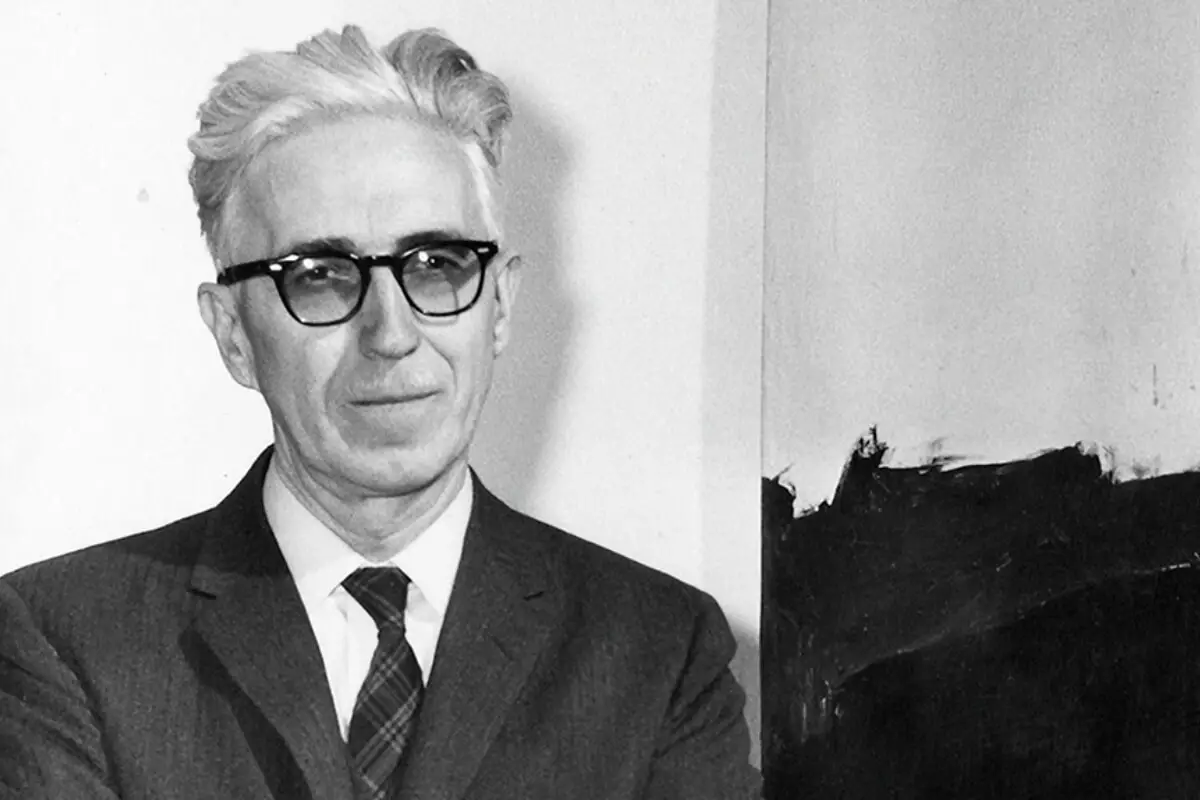The journey into the world of Abstract Expressionism, mainly through the lens of Clyfford Still’s contributions, invites us to consider the profound impact that shifts in artistic direction can have on the broader landscape of art.
As we traverse this narrative, we engage with how Still’s approach to painting challenges and redefines our understanding of emotional expression through visual art.
Table of Contents
- The Genesis of Abstract Expressionism
- The Philosophy Behind the Canvas
- The Visual Language of Emotion
- The Legacy of Rebellion
- The Enigma of Clyfford Still
- The Impact on Future Generations
- Related Questions
The Genesis of Abstract Expressionism
Starting with figurative painting, Clyfford Still took a hard turn towards abstraction, which had a game-changing impact on art. His shift wasn’t just a change of style; it was like breaking the sound barrier in the art world. Suddenly, bold slashes of color and jagged forms began splattering across his canvases, leaving observers baffled and mesmerized.
Still’s paintings don’t show the careful depiction of people or landscapes but a storm of emotions captured on canvas. It’s as if he opened a door into a realm where feelings and colors mix freely without the constraints of physical form. This approach was radical, to say the least, and set the stage for what we now know as Abstract Expressionism.
But what drove Still to this groundbreaking approach? His early works, rooted in realism, already hinted at a restless spirit eager to explore beyond conventional boundaries. The economic despair of the Great Depression and the horrors of World War II deeply impacted many artists of his time, pushing them to search for new means of expression. For Still, this translated into vibrant, abstract works that sought to capture not the outer world but the inner turmoil and ecstasy of human existence.
His canvases are like visual symphonies, where color and texture play the roles of musical notes, creating an intense experience for the viewer. By detaching art from its traditional role of depicting the observable world, Still invited viewers to engage directly with the art on an emotional and intellectual level. This bold move questioned the very purpose of art, paving the way for Abstract Expressionism to flourish.
Moreover, Still’s influence extended beyond his canvases. His defiant independence and philosophical approach to art resonated with many contemporaries exploring abstraction. Artists like Jackson Pollock and Mark Rothko shared Still’s fascination with conveying emotion through abstract forms, leading to a collective movement that would change the art world forever.
The cultural chaos of the 1940s and 1950s, marked by rapid technological advancements and existential threats, made Still’s abstraction particularly appealing. It offered an artistic language that could express the complexity and anxiety of the modern age. Instead of looking back, as artists traditionally did, Still and his fellow Abstract Expressionists looked inward, ushering in a new chapter in art history where emotion took precedence over representation.
It wasn’t just within the confines of painted canvases that Still made his mark. His influential teachings and outspoken critiques of the art establishment played a crucial role in nurturing a community of thinkers who dared to imagine art as something more profound than mere imitation. By advocating for an art that delved into the depths of human consciousness, he laid down the intellectual foundations of Abstract Expressionism.
Through his experimentation with form, color, and space, Clyfford Still tore down the walls that confined artistic expression, allowing future artists to explore the boundless possibilities of abstraction. His pioneering work contributed to the birth of Abstract Expressionism. It inspires artists and art lovers alike to see beyond the visible world into the vast territories of the human psyche.
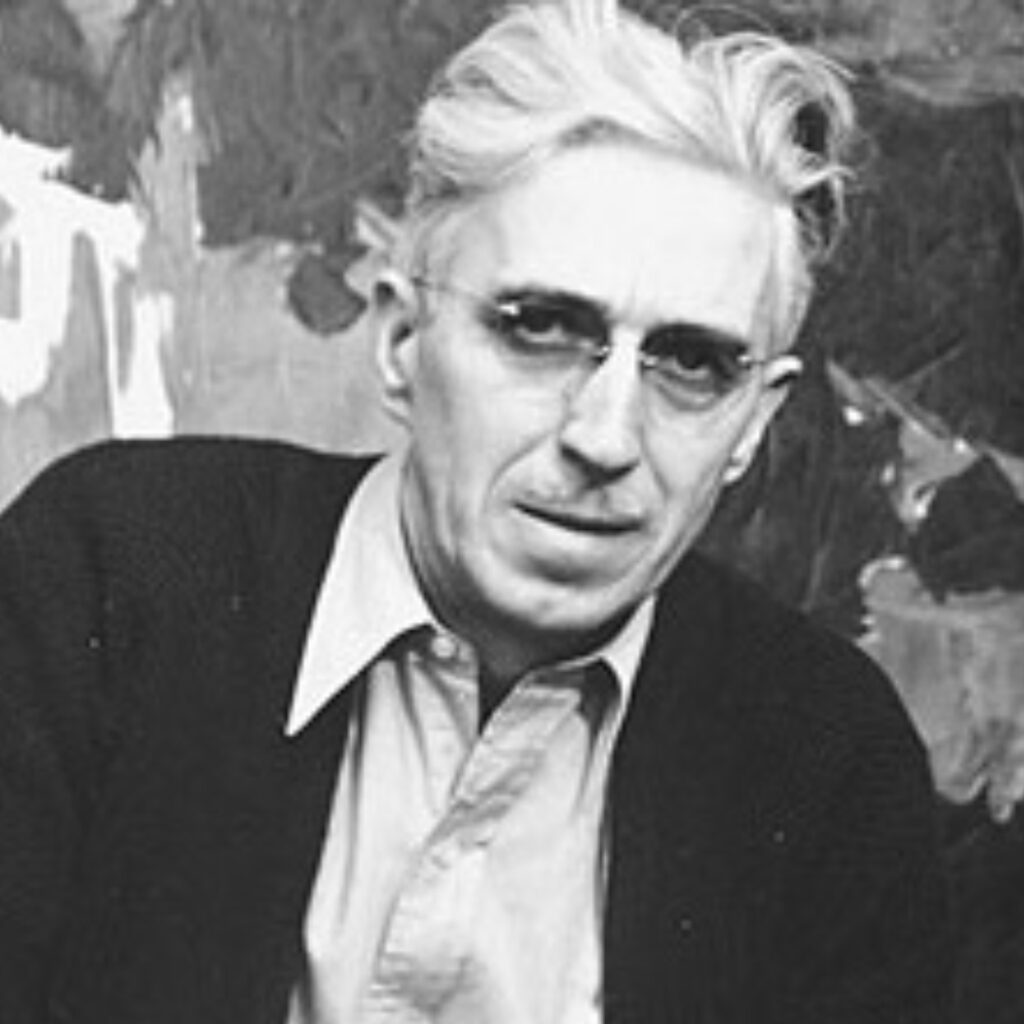
The Philosophy Behind the Canvas
Clyfford Still’s artistic journey doesn’t just rest with his move towards abstraction or the textural intrigue his canvases undeniably possess; it deeply embeds within the philosophical arenas he ventured into, framing his oeuvre as a bridge between the visible and the existential.
Peeling back layers of his work reveals a profound engagement with existential philosophy, notably the concepts of freedom, isolation, and existential angst. These weren’t mere backdrops for his art; they were integral to the strokes and contours he created, breathing life into the canvas with each swipe of his palette knife.
Exploring Still’s work further unravels his keen interest in ontology – the philosophical study of being. This inquiry is palpable in the way Still approaches the canvas, not merely as a surface for painting but as a space where existence and non-existence meet. The expansive, often dominating color fields invite contemplation on the viewer’s part, questioning the nature of existence and our place.
This metaphysical reflection becomes a silent dialogue between the creator, the creation, and the observer, each searching for answers in an ambiguous world.
Still’s individualism shines brightly when dissected through a philosophical lens. Echoes of Emersonian self-reliance permeate his work, proposing a fiercely independent art unyielding to his time’s reigning art institutions or movements. This philosophical underpinning in Still’s creation is a defiant reaffirmation of personal freedom against the constraints of society, presenting the artist not just as a creator but as an existential rebel.
Nature was not merely a larger-than-life backdrop for Still’s expressive endeavors but a constant philosophical touchstone. He saw nature as a force intertwined with the existential journey, reflecting both creation’s magnificence and chaos.
This vibrant duality in nature resonated with Still, pulling it into his canvases, where life and death coexist in evocative abstraction. In such works, nature transcends physical boundaries, becoming a dynamic essence that captures life’s inevitable cycle and impermanence’s raw beauty.
Spirituality, although abstract and non-denominational, coils through Still’s oeuvre. His paintings, radiating with a spiritual luminosity, seem to bypass conventional religious iconography to tap into something profoundly universal – a kind of secular mysticism that offers solace not in answers but in accepting the profound mysteries of existence. Through this lens, his paintings can be seen as canvases of meditation, where silent energies course through the vibrant cracks and colors, inviting a deeper, reflective communion.
Furthermore, Still’s art can be perceived as an intimate wrestle with loneliness and isolation – themes that frequently punctuate existential philosophy. Yet, instead of surrendering to despair, his canvases present isolation as a condition that can birth profound awareness and creativity.
In this solitude, Still finds a unique voice that channels the complexities of the human condition through stark contrasts and bold separations on his canvases.
Grounded in such diverse philosophical reflections, Clyfford Still’s paintings transform into narratives far beyond their visual allure. They unfold as existential explorations that mirror the artist’s introspections into life, death, freedom, nature, and spirituality, reminding us that underpinning these grand landscapes are the ancient queries of existence that continue to puzzle humanity.
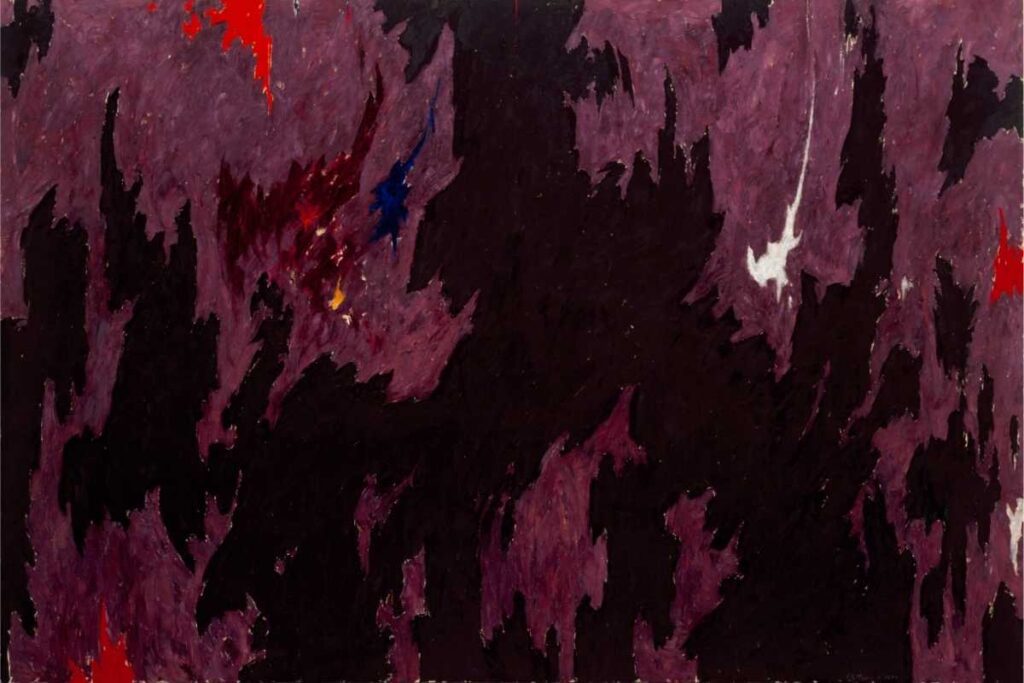
The Visual Language of Emotion
Delving further into Clyfford Still’s artistry reveals his ingenious manipulation of color and form to stir emotions within the observer. The amalgamation of jagged lines tearing across the canvas embodies a raw, almost primal energy. These lines, at times resembling lightning strikes or fissures in the earth, serve as a visual metaphor for the tumultuousness of the human condition. Their unpredictable paths across the canvas convey a sense of movement and tension, pulling the viewer’s eye and emotions in multiple directions.
The expanses of color that dominate Still’s canvases are not merely backdrops; they are profound actors in the emotional narrative of each piece. Deep reds can evoke passion or violence, while dark voids suggest the unknown or the abyss. The boldness of these colors does not shout but instead whispers intimations of deep-seated emotions and thoughts, engaging viewers in a silent dialogue about their interior landscapes.
Still’s strategic use of negative space is another tool in his emotional arsenal. These voids, often stark and unsettling, push the vibrancy of his color fields to the forefront, making them even more impactful. The interaction between the painted areas and the untouched canvas creates tension, a visual push and pull that mirrors the complexities of human emotions and relationships.
The psychological impact of Still’s color choices cannot be understated. Colors are not chosen haphazardly but are imbued with psychological nuances that resonate on an almost subconscious level with the viewer. For instance, using a tumultuous black against a vibrant orange can invoke a sense of danger or foreboding. At the same time, a gentle gradient from blue to white might spark a feeling of serenity or contemplation.
This nuanced approach to color and form allows Still to construct a multi-layered emotional experience. His paintings become arenas where viewers can confront and reflect upon their feelings and reactions. This interaction between the artwork and the observer is fundamental to Still’s aim of transcending the mere visual to reach emotional and existential depths.
In summary, Clyfford Still’s mastery lies in his ability to harness color and form in ways that go beyond aesthetic pleasure, challenging viewers to embark on introspective journeys.
Through his inventive use of jagged lines, expansive color fields, and calculated voids, Still invites a deeper exploration of human emotions and existential realities. The psychological depth of his color choices further amplifies this experience, making each painting a visual and emotional journey. This unique blend of elements works in concert to create a visceral impact that lingers with the viewer, cementing Still’s legacy as a pioneer in abstraction and evoking emotion through art.

The Legacy of Rebellion
Clyfford Still’s defiance against the art establishment was not just a personal choice but a crusade against what he perceived as the commodification of art. His dissatisfaction with the commercial art scene in New York led him to sever ties with nearly all the city’s galleries. He still believed that art should transcend commerce, a principle that guided his creation of art and its presentation and conservation. He famously said, “My paintings should not be treated as commodities.”
In an era when artists sought the support of influential galleries and collectors to attain success, Still took a bold stand by refusing to play by these established rules. He was critical of fellow artists who, in his view, sold out their originality for commercial success. This stance isolated him from parts of the art community but also bolstered his reputation as an uncompromising visionary.
His ultimate act of defiance came toward the end of his life when he made a will dictating that the bulk of his unsold work—over 2,000 pieces—would go to an American city willing to build a museum dedicated solely to his art.
This move was unparalleled, as it demanded an unprecedented commitment from a public institution and ensured that Still’s work would be preserved according to his staunch philosophies regarding art presentation. The city of Denver accepted this challenge and established the Clyfford Still Museum, thus fulfilling Still’s requirement and reinforcing his lasting impact on how art could be experienced beyond the traditional confines of the commercial art world.
Moreover, Still’s criticism of the art market wasn’t limited to verbal denouncements or strategic will-crafting. He also physically distanced himself from New York, the then epicenter of the art market, moving to rural Maryland. This geographical separation further emphasized his need for artistic freedom, unencumbered by the demands and influences of art dealers and collectors.
He also refused numerous lucrative offers for his works, underscoring his belief that the value of art lies beyond monetary assessments. By prioritizing the integrity and autonomy of his creative process over commercial gain, Still set a precedent that challenged other artists to consider the essence and purpose of their work.
His battle wasn’t solely against commercialism but also extended to criticism and interpretation. Still was known for his reluctance to explain his art, believing it should speak for itself without being confined by textual interpretations.
This stance resisted the growing trend of art criticism dictating how artworks should be understood, further distancing him from the conventional art establishment that heavily relied on such narratives to valorize art.
Still’s rebellious spirit manifested not just in his words and actions but also in the ethos that imbues his canvases—an indomitable quest for authenticity, freedom, and personal expression in an age marked by rapid commercialization and conformism.
Through his steadfast commitment to these principles, Still carved a unique path for himself and left an indelible mark on modern art. He challenged future generations to preserve the sanctity of creative expression against the encroaching forces of commercialism.

The Enigma of Clyfford Still
Clyfford Still’s enigma partly stems from his deliberate distance from the limelight, prioritizing solitude over public acclaim. This reclusion extended to his art—rarely selling or showing his work, he kept a tight rein on his artistic narrative. Compounding by fierce independence, his insistence on privacy made him a fascinating and elusive figure. Decades after his prime, understanding Still requires peering into the shadows he preferred to inhabit.
Still’s relational dynamics with the broader art scene further cloaked him in mystery. Unlike peers hungry for galleries and acclaim, Still mostly shunned the New York art scene’s glamour and politics. His sporadic participation made each appearance or absence a statement of intent, enhancing his enigmatic reputation. This strategic withdrawal from the public eye left many questions unanswered, making every discovered detail about his life or thought process a treasure for interpretation.
For those lucky enough to encounter Still’s work in person or through rare exhibits, his intense privacy can feel like a challenge—a puzzle where each piece unlocks a little more of his vast, intricate worldview. This scarcity of work in the public domain adds layers to the mystique, creating an insatiable curiosity about the man behind the canvases. Each piece feels like a rare glimpse into Still’s complex, obscured by choice universe.
Complicating Still’s narrative is his hard-to-pin style. His work defies easy categorization, standing distinctly apart from even those artists he influenced. This resistance to being boxed into a single art movement or style poses significant challenges to critics and historians attempting to track his contributions. While contemporaries might be celebrated within specific schools or movements, Still’s oeuvre spans and spirals out, encompassing a broader spectrum of expression and thus making conventional analysis difficult.
The Clyfford Still Museum in Denver is a beacon for those seeking to unravel the man’s mysteries. Here, dedicated efforts aim at bridging gaps between Still’s public persona and his private endeavors. The museum offers a rare enclave where enthusiasts can immerse themselves in Still’s vision, providing context and connecting dots between the artist’s life events and his evolving art. Such institutions are invaluable in demystifying Still, allowing new generations to appreciate his legacy and contribution to modern art.
His contentious relationship with art institutions added another layer to his complex persona. Still’s vocal critiques of museums and galleries, viewed as constraints to creative freedom, positioned him as an outsider challenging the status quo. This audacious stance created a paradox: a renowned artist simultaneously at the core and periphery of the art world. His strict conditions for exhibiting or selling his work reflected a philosophy that art’s value transcended the market, emphasizing integrity over profit.
Yet, there’s a compelling invitation to delve deeper beyond the surface within this withdrawal and solitude. Still’s staunch belief in art for art’s sake challenges observers to interact with his work without the noise of biographical context or societal expectations. This invitation into an unmediated emotional experience fuels ongoing fascination with Still’s art. His capability to evoke robust, raw responses through abstraction remains a testament to his genius, compelling even those who might not unravel the full depth of his life’s work.
Understanding Clyfford Still isn’t just about piecing together fragments of his personal history or analyzing his vast body of work. It’s also about recognizing the intention behind his elusiveness—the desire to let the art speak for itself, unencumbered by the narratives that so often color our perceptions of creativity. In this light, Still’s enigma isn’t a barrier but a bridge to a purer engagement with what lies at the heart of artistic expression: the transcendent power of human emotion and intellect, rendered visible on canvas.
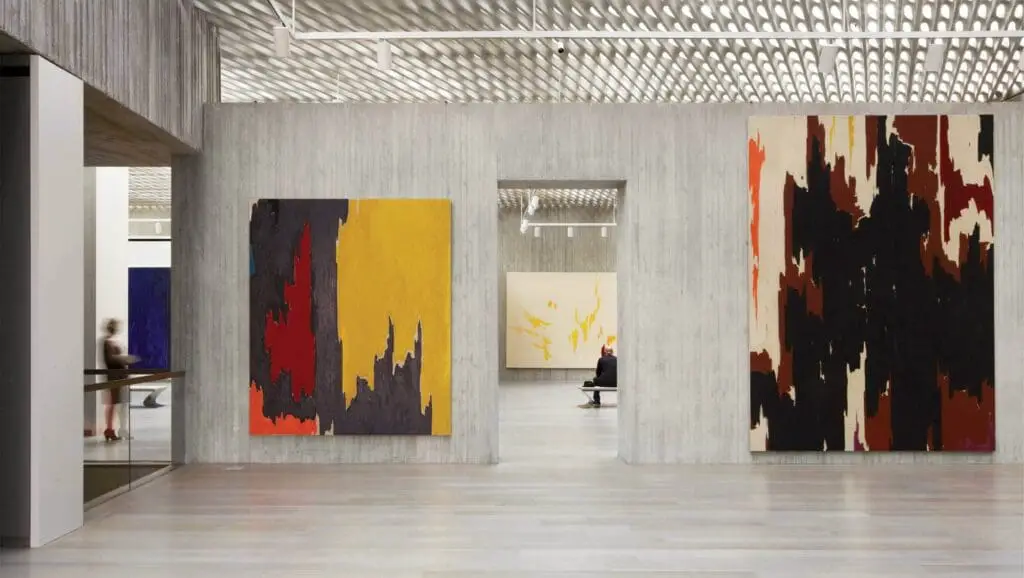
The Impact on Future Generations
Clyfford Still’s bold strides into abstraction blazed a trail not just for his contemporaries but also for the generations of artists who followed, shaping the course of modern art in profound ways.
Today Still’s revolutionary methods and philosophical musings continue to ripple through the art community, urging a reconsideration of art’s role in expressing the human experience. Artists across diverse genres draw on Still’s technique of using vast canvases to showcase dramatic clashes of color and form, attempting to capture the complexities of the human soul as Still did.
In the hands of contemporary artists, Still’s influence becomes a dialogue about abstraction’s capacity to articulate the ineffable aspects of our existence. This is evident in current works that employ abstraction to wrestle with themes of identity, technology, and environmental concern, echoing Still’s pursuit of capturing life’s profundity. His insistence on art’s power to evoke deep emotional responses finds a home in modern installations and digital mediums, where immersive experiences seek to overwhelm the senses like Still’s monumental works do.
Still’s contribution to breaking away from traditional portrayals of landscapes and figures inspired artists to see the familiar in radically new ways. This legacy illuminates paths for artists exploring minimalist or conceptual projects, pushing them to strip down their message to its rawest form, like Still stripped away the unnecessary, focusing instead on the dynamic characteristics of color and texture.
Moreover, Still’s philosophical engagement with existential themes has encouraged contemporary makers to infuse their works with personal mythologies and metaphors, bridging the universal and the individual. By emulating Still’s blending of the personal with the universal, artists keep conversations on ambiguity and essence alive within their creations.
Importantly, Still’s defiance against the commodification of art and his critique of the art establishment provides a touchstone of integrity for artists navigating today’s digital marketplace. As creators aspire to maintain authenticity in an era where social media and online platforms increasingly commoditize art, Still’s ethos serves as a beacon for those seeking to prioritize artistic integrity over popularity or financial success.
The visual vocabulary that Still developed also offers a lexicon for artists seeking a semblance of balance between chaos and order, reflecting societal tensions in a world fraught with uncertainties. By delving into abstract forms, artists find in Still’s work a precedent for conveying resilience and hope amidst adversity.
Furthermore, Still’s isolative creation process and skepticism towards art institutions challenge today’s artists to interrogate their relationship with galleries and audiences, promoting a culture of introspection and self-sufficiency in art making. His approach underscores the importance of solitary reflection and the value of art that refuses easy categorization, enriching contemporary narratives around independence in creative expression.
The establishment of the Clyfford Still Museum acts not just as a repository of his work but as an epicenter from which his radical ideas permeate contemporary discourses on art’s function and form. Through the museum’s existence, a new generation accesses and interacts with Still’s oeuvre, ensuring that his contributions continue to provoke and inspire.
Clyfford Still’s indelible impact on modern art resonates in today’s artistic practices, continuously exploring abstraction’s potential to narrate the human condition. His legacy lives on as a testament to the power of art to confront, challenge, and transcend our understanding of ourselves and the world around us.

In essence, Clyfford Still’s legacy is a testament to the transformative power of art to communicate the depths of human emotion and intellect. His work inspires and challenges us, encouraging a deeper engagement with the visual language of abstraction to navigate our own experiences and perceptions of the world around us.
Listen To Our Podcast About
What Defines Clyfford Still’s Artistic Journey? Below or By clicking here.
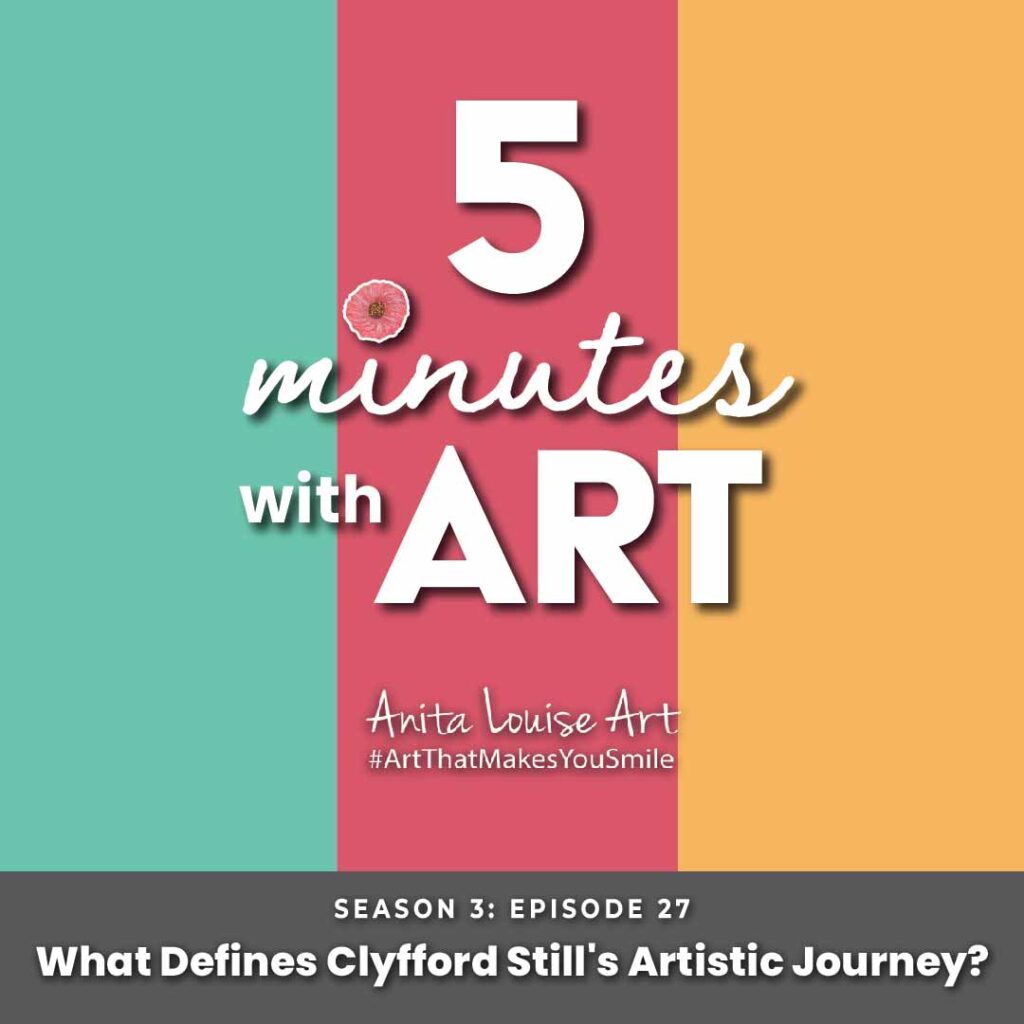
Anita Louise Art is dedicated to art education, great artists, and inspiring others to find and create their art. We love art that uplifts and inspires. #ArtToMakeYouSmile! #ArtToMakeYouHappy!
If you are interested to see any of my art, you can find out more by clicking here. If you are interested in what inspires me and my paintings, you can discover more by clicking here.
We have a free newsletter and would love you to be part of our community; you can subscribe to the newsletter by clicking here. I would be happy to talk to you if you have any questions. You can reach me, Anita, by clicking here.
Subscribe to our Anita Louise Art YouTube Channel with great videos and information by clicking here.
Join us for our podcast “5 Minutes With Art.” Spend just 5 minutes a week with us to discover and learn about great art and artists. You can find out more about our podcast by clicking here.
Related Questions
What Was The American Gothic Painting by Grant Wood (1930)?
Grant Wood, the artist, was from Iowa. His painting American Gothic has a Carpenter Gothic Style house with a stoic man with a pitchfork and women staring off to the side outside the house. The painting received a 3rd place finish in an art competition at the Art Institute of Chicago. The painting has a lot of ambiguity, which leads to speculation about its true meaning. But all this ambiguity has raised its profile over the years.
You can read more by reading our blog, 17 Facts About the American Gothic Painting by Grant Wood (1930) by clicking here.
Who Was Georgia O’Keeffe, The Mother of American Modernism Painting?
Georgia O’Keeffe was a dairy farm girl from Wisconsin who became one of America’s great iconic painters. She received some college education but had to leave college due to her father’s untimely bankruptcy. When she was in school in New York, she met her future husband, the photographer and gallery owner Alfred Stieglitz. She is best known for her many American western subject matters and oversized flowers that she painted. She had a home and studio in the US state of New Mexico. You can visit her home in New Mexico and the Georgia O’Keeffe Museum in Santa Fe, New Mexico.
You can find out more by reading our blog Georgia O’Keeffe, The Mother of American Modernism Painting by clicking here.
Who Is the American Artist Norman Rockwell (1894-1973)?
Norman Rockwell is one of the most iconic American artists. His popular illustrations about daily life in America were on the front cover of the Saturday Evening Post magazine for over 47 years. Rockwell received success early and life. His artwork was in all the popular publications of his day. Today you can see many of his works of art at the Norman Rockwell Museum in Stockbridge, Massachusetts.
You can learn more by reading Who Is the American Artist Norman Rockwell (1894-1973)? by clicking here.

